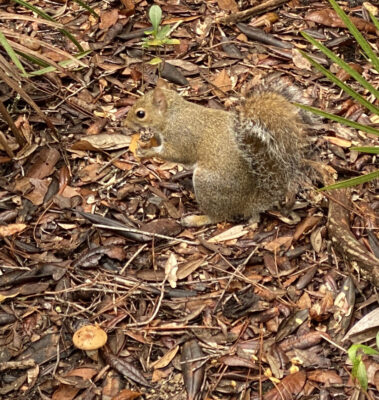By Pat Foster-Turley

For years there has been controversy about what to do with the “extra golf course land” adjacent to the Fernandina City Golf Course. My own yard backs up to this wooded property so I’ve been paying close attention over the years. Finally, a few years ago, this matter was settled. Five or more acres of this plot has become Simmons Park, a passive park, perfect for dog walkers, bird watchers and strollers. The loop around the park is one-quarter of a mile on a smooth, level path with well-placed benches that make it easy for even an impaired walker to make their way around it.
The last time I walked this path I was no longer focused on my former hip pain and instead paid close attention to the nature surrounding it. This time of year the path is mostly mosquito and gnat-free, the air is cooler, and the quiet is only broken by a few bird calls, and the rustling of squirrels in the trees. Rounding one bend in the trail I encountered a squirrel feeding on mushrooms, an interesting sight. I noticed the new benches and adjacent signs describing more about the birds, bees, butterflies, and other critters that live in this habitat.

But then I started noticing the exotic invasive plants. Due to a massive effort by the “Invader Raiders” volunteer group organized by Kathy Russell, for the city of Fernandina Beach, many of these have already received attention and strong efforts have been made to remove as much of them as possible. The most offensive invasive plant here is the air potato vine. A few traces of this plant still exist, but happily, the specialized beetles that were released here a few years ago are busy attacking these remnants. The remaining air potato plants are behind private homes, where they can easily spread back into the park. These vines can grow up to eight inches a day and quickly overwhelm native plants with their large heart-shaped leaves. If you want to see them, take a closer look at the vegetation on Amelia Island Parkway near the Ritz Carlton. And if you have any in your backyard, please do your best to remove them, collect the potato-shaped fruits, and put them all in plastic bags to be discarded. These plants are very hardy and the “potatoes” sprout easily, so don’t toss them in a pile somewhere, since these will spread further from there.

Because Simmons Park borders our backyard, I wandered off the main trail and along the mosquito ditch that divides our property from the park. And, what was that, in a clearing in the woods? I found a stake in the ground, with a yellow pool noodle covering it. I reported it to Kathy Russell, the city conservationist, and she inquired throughout the city departments and, despite this marker being on city land, no department claimed knowledge about it. A social media post also revealed no further information.
So, one day Kathy Russell and City Arborist David Neville accompanied me on a walk back to the area to look at, and then, to remove the extraneous yellow post. It was a good thing we did. The yellow post was not nearly as problematic as the two exotic invading plant species that Kathy and David discovered on this walk. One plant, coral ardisia was laden with white berries, not the more common red berries that made this plant a popular horticultural plant. Now this plant is prohibited in Florida due to its habit of forming dense mats of undergrowth that crowd out native plants. And, sadly, the berries of coral ardisia are thought to be poisonous if ingested by native wildlife.

It didn’t take long for Kathy to spot another non-native plant species there too, the Chinese tallow. This plant can grow into a tree, then many trees, that shade out native plants. Chinese tallow has already been the focus of large-scale exotic plant removal efforts in the Egans Creek Greenway.
Now it looks like the Invader Raiders will also have another area to work on in Simmons Park. This work is endless but necessary to protect our native natural resources. But these volunteers alone are not enough to stem the tide. Your help is also needed. Please inspect your yard for these plants and remove them. Be sure to bag them up in plastic—don’t toss them in a pile somewhere where they will continue their disturbing spread.
It takes us all to protect our island. Please do your part to help.
Pat Foster-Turley, Ph.D., is a zoologist on Amelia Island. She welcomes your nature questions and observations. [email protected]

Thanks, Pat for alerting us about these invasive species. One problem is when neighbors do landscape work in their own yard, and then throw their old and dug-up plants over the fence onto public property. That just helps spread these insidious plants. Please bag them up and put them in the garbage. Thanks.
Always enjoy reading your informative articles! This one is especially important! With our area being inundated with growth, it IS very important to protect the native species of plants. These are but a few of the “invaders” we need to be mindful of. Visit the UF IFAS website to learn more about non-native invasive plants that we need to protect our environment from.
I always enjoy Pat’s articles, especially this one. Awareness of invasive plants is important, know what is growing on your property. There are many invasive plants on the island, just look around downtown. Several are purchased in stores. Thanks Pat!
Pat wouldn’t it be more advantageous to burn invasive plants once pulled up rather than putting them in the trash where they will likely end up in some landfill to respawn and invade again? Asking for a friend.